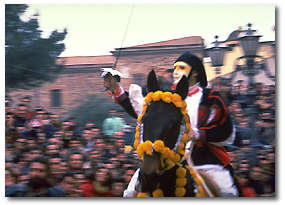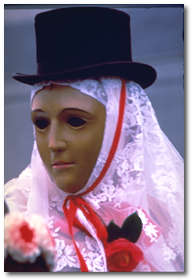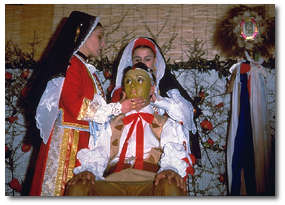According to tradition, in order to avoid
the fights that occurred at Carnival between the "Arborensi" and Aragonese soldiers who
were hated by the local people for having defeated them and taken their land, a Canon pasted a law
giving the "Farmers’ Gremio" the right to continue the "Sartiglia". Under
this law man-to-man fighting was forbidden. This also helped to spread the cost of the large lunch
given to the horsemen who participated in the tournament.
|
|
 |
The tradition is confirmed by the fact
that the Farmers’ Gremio still continues to hold the "Su Cungiau de Sa Sartiglia"
(in the Sardinian language) that allows the running of the tournament.
On Sunday, Sartiglia takes place under San Giovanni Battista’s protection. On Tuesday, Sartiglia
is organized by the Carpenters’ Gremio and takes place under San Giuseppe’s protection.
|
 |
|
The traditions are stratified in time and
surround the unique main character, the King of Sartiglia (Su Compoidori in Sardinian
language) and his androgynous mask. He is the master of the festival. Man and woman at the same time,
neither female nor male. Every year Su Cumpoidori is ‘born’ when he is dressed in
public by very beautiful girls wearing ancient traditional costumes. Sartiglia starts this way with
the dressing of the "Su Cumpoidori", (the head of the races) and this is one of the
most obscure rites among Sardinian traditions.
They are the two Gremi who chose among many candidates the person who is going to be "Su
Cumpoidori". There are ancient rituals which reach their peak in the dressing of "Su
Cumpoidori" on race day. It is a rite full of sacredness because "Su Cumpoidori" must
be strong, pure and brave. He has to become a devotee of fecundation, the purity of which is
ensured - on the day before Sartiglia - with confession and Communion.
|
The "Su Cumpoidori" is
dressed on a table which is really an altar. It is decorated with wheat and flowers in S’Oberaju
Majori’s (the head of the Gremio) house. From that moment, "Su Cumpoidori" is not
allowed to touch the ground.
|
Any direct contact with the "Big
Mother" must be avoided so that "Su Cumpoidori" can preserve the purity that is
essential to compete and win. "Sas Massaieddas" are young virgin girls in traditional
costumes who dress "Su Cumpoidori". They are lead by the so-called "Sa Massaia
Manna". "Su Cumpoidori" is not allowed to touch the clothes. It is a real ceremony, a
long rite, attended by a narrow circle of people in silence.
|
|
 |
|